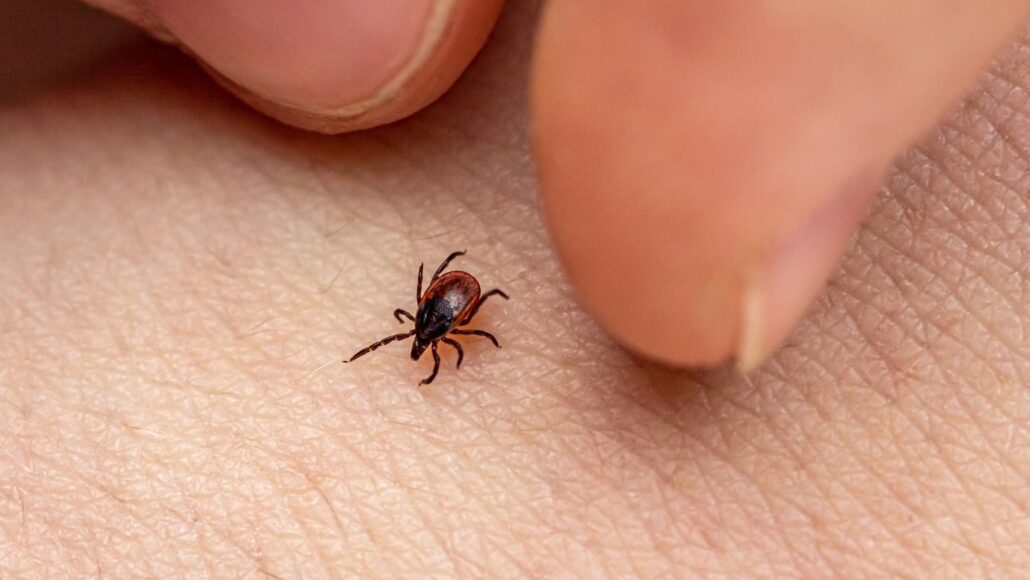A protein in sweat may protect people from Lyme disease
The protein kept disease-causing bacteria from growing in lab dishes or infecting mice

Sweating may give people some protection against Lyme disease. People can become infected with Lyme when bitten by a tick carrying a certain bacterium. But a protein in human sweat kept that bacterium from growing in lab dishes or from infecting mice.
rbkomar/Moment/Getty Images
Share this:
- Share via email (Opens in new window) Email
- Click to share on Facebook (Opens in new window) Facebook
- Click to share on X (Opens in new window) X
- Click to share on Pinterest (Opens in new window) Pinterest
- Click to share on Reddit (Opens in new window) Reddit
- Share to Google Classroom (Opens in new window) Google Classroom
- Click to print (Opens in new window) Print
Breaking into a cold sweat over a tick bite may have its benefits.
When a tick carrying the bacterium Borrelia burgdorferi bites someone, it can give them Lyme disease. This infection can cause a fever, headache and skin rash. If not treated, it also can harm someone’s joints, heart and nervous system. But a protein in human sweat may help protect against B. burgdorferi, data now suggest.
Researchers shared these new findings March 19 in Nature Communications.
Michal Tal studies the immune system. She works at the Massachusetts Institute of Technology in Cambridge. “When we talk about risk factors for [getting] Lyme, we generally talk about camping, golfing, maybe gardening,” she says. All those outdoor pastimes may expose someone to tick bites.
But people seldom worry about getting Lyme during sweaty outdoor hobbies such as trail running. “It’s never even been a question of whether … you were sweating, and if you had any protection in your sweat,” Tal says. Her team’s new work suggests that, in fact, sweat may help guard against Lyme disease.
Genes and proteins
Tal and her colleagues looked at data on the genes of some 620,000 people. All had been to hospitals or clinics in Finland or Estonia. More than 25,000 of them had been diagnosed with Lyme disease.
Three genes seemed to be linked with risk of getting Lyme. Two of those genes tell cells in the body how to make proteins that spot harmful germs. The third gene tells cells how to make a protein called SCGB1D2. That last find was “totally unexpected,” says team member Hanna Ollila. “We didn’t really know anything about [that protein].” Ollila studies genetics at the University of Helsinki in Finland.
SCGB1D2, it turns out, is made by sweat glands. And it may show up on the skin — the body’s first line of defense against tick bites.
In lab dishes, SCGB1D2 stopped Lyme-causing bacterium from growing. Next, the researchers mixed that microbe and the protein together in test tubes. Mice injected with the mix didn’t become infected. This hinted that SCGB1D2 blocks B. burgdorferi bacteria from infecting mice.
A closer look at the anti-Lyme protein
Not everyone, it seems, is armed with an equally strong anti-Lyme defense. About four in every 10 people in this study carried a mutated version of the SCGB1D2 gene. In lab dishes, it took twice as much of that version of the protein to slow the growth of B. burgdorferi. What’s more, mice injected with the mutated protein, alongside the bacteria, did become infected with Lyme.
The results hint that the normal version of SCGB1D2 might one day be used to treat Lyme disease. If so, that could help a lot of people. Lyme is the most common infection that people get from ticks in the United States and Europe.
SCGB1D2 also might be used to prevent B. burgdorferi from infecting people. But “there’s still a lot of work that remains to be done for us to see just how much potential it has,” Tal notes.
Adela Oliva Chávez at the University of Wisconsin–Madison did not take part in the work. But she does study how ticks transmit disease to other animals. The new results leave her wondering how SCGB1D2 and B. burgdorferi might interact at the site of a tick bite. Tal’s team studied how the protein and bacteria interact when injected into a mouse. But ticks might have some way of making the protein less effective on the skin at the moment of a bite. If so, Oliva Chávez points out, the new experiments wouldn’t show it.
There are still many unknowns, she says. Still, “I’m excited, with caution.”







